香港市城市规划——最后文件
- 格式:pptx
- 大小:5.62 MB
- 文档页数:19
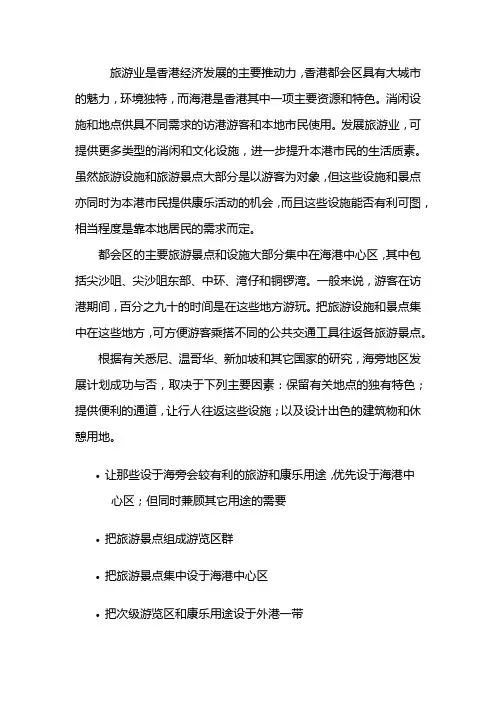
旅游业是香港经济发展的主要推动力,香港都会区具有大城市的魅力,环境独特,而海港是香港其中一项主要资源和特色。
消闲设施和地点供具不同需求的访港游客和本地市民使用。
发展旅游业,可提供更多类型的消闲和文化设施,进一步提升本港市民的生活质素。
虽然旅游设施和旅游景点大部分是以游客为对象,但这些设施和景点亦同时为本港市民提供康乐活动的机会,而且这些设施能否有利可图,相当程度是靠本地居民的需求而定。
都会区的主要旅游景点和设施大部分集中在海港中心区,其中包括尖沙咀、尖沙咀东部、中环、湾仔和铜锣湾。
一般来说,游客在访港期间,百分之九十的时间是在这些地方游玩。
把旅游设施和景点集中在这些地方,可方便游客乘搭不同的公共交通工具往返各旅游景点。
根据有关悉尼、温哥华、新加坡和其它国家的研究,海旁地区发展计划成功与否,取决于下列主要因素:保留有关地点的独有特色;提供便利的通道,让行人往返这些设施;以及设计出色的建筑物和休憩用地。
∙让那些设于海旁会较有利的旅游和康乐用途,优先设于海港中心区;但同时兼顾其它用途的需要∙把旅游景点组成游览区群∙把旅游景点集中设于海港中心区∙把次级游览区和康乐用途设于外港一带∙改善公共运输系统与海旁行人信道的连接∙辟设更连贯的海滨长廊,把各个旅游景点连接起来∙通过改善视觉、景观和行人连接系统,把毗邻地区与公众海旁地区融为一体∙尽量避免破坏海港的环境和景观,以及保存天然海岸线港口:涵盖专门负责处理经水路运送的货物的主要地区,例如货柜码头。
海事:涵盖维港主要水域中指定作航运用途的地区,例如航道和系泊浮标,以及可能会用作举行特别活动的其它水域。
旅游:现有及建议的主要旅游景点和设施,包括酒店、与旅游有关的零售商店及餐厅、码头、以及预计游客会经常使用的地方,例如散步长廊、广场和主要公园等。
康乐:包括可满足附近居民的康乐需要、但游客却未必会经常使用的其它设施,例如地区公园、散步走廊和一些地区景点等。
住宅及工业:包括位于海旁及其附近的现有用途。

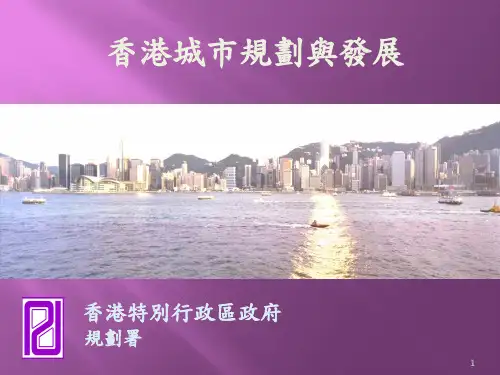

一、规划三剑客西九文化区概念规划方案香港西九文化区的建设项目恐怕是当今世界上规模最大,最雄心勃勃,也是一直富于争议性的文化建设项目。
8月20日,备受关注的文化区三个规划方案终于出台了!三家规划设计顾问公司——英国的Foster + Partners(以下简称福斯特),香港的许李严建筑师事务有限公司(以下简称许李严或严讯奇)和荷兰的OMA(以下称OMA或库哈斯),各自领取酬金约4,900万港元,经过一年的闭门铸造,终于向香港公众亮出自己的绝招。
三个概念规划方案自8月21日起在香港会展中心等地展出,进行为期三个月的公众咨询,收集市民意见,最后西九文化区管理局将“综合各方意见”选取一个主导方案。
“西九兴亡,匹夫有责”。
我去仔细看了展览,研读了各设计公司提供的资料,产生一些个人看法,想提出来,与大家交换意见。
在直接讲我个人看法前,我认为有必要先分析一下基地的现状——这是我评判各方案的出发点。
西九头顶几大怪我们香港城市有诸多特色,其中包含两大精髓:便利的公共交通和生机勃勃的街道文化。
前者体现为发达的地铁、公交、电车、航船线路以及相互间便捷的接驳;后者体现为密集的街道网络、频繁出现的街道交叉口、小尺度的街区划分、沿街多样的小商业设施、以及——很重要的——似乎永远都不缺的人气——步行人流。
有时走在铜锣湾、旺角的街道,我也会觉得有点太过拥挤。
也许人口密度稍低点,街道稍宽些会让人更感舒适。
但这只是个度的调整问题,香港街道文化的本质构成总的说来是值得我们珍惜的。
总之,便利的交通加上街道文化这两大精髓,结合其它特征,形成的良好城市空间格局在港岛、九龙比比皆是。
但是,西九文化区周边的城市环境现状如何?相信去过的人大多会同意我,也有两大特点,与香港的城市精髓恰恰相反:极差的公共交通通达性和极端反人性的步行环境!与紧靠东边的尖沙咀和油麻地两个片区的小尺度街区划分、密集的街道网络、方便步行的街区环境、热闹非凡的街道生活相比,西九片区简直就是城市生活的死角和荒漠。
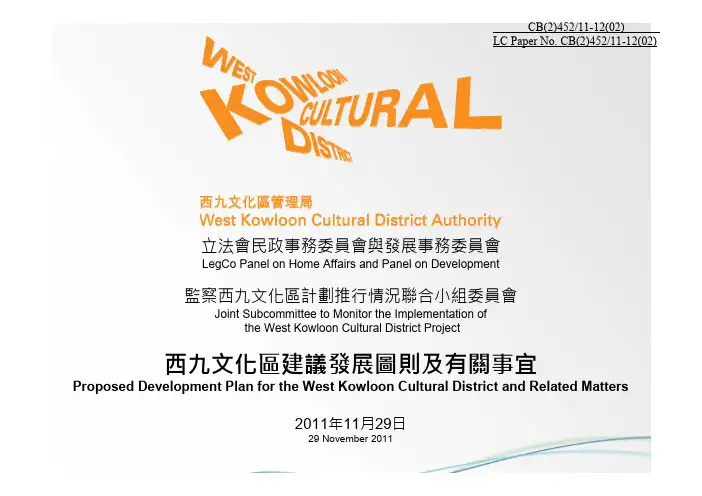

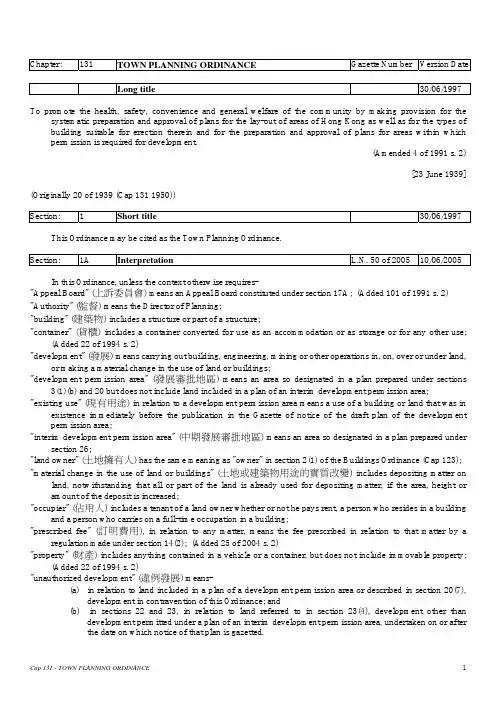
Chapter: 131 TOWN PLANNING ORDINANCE Gazette Number Version DateLong title 30/06/1997 To promote the health, safety, convenience and general welfare of the community by making provision for the systematic preparation and approval of plans for the lay-out of areas of Hong Kong as well as for the types ofbuilding suitable for erection therein and for the preparation and approval of plans for areas within whichpermission is required for development.(Amended 4 of 1991 s. 2)[23 June 1939](Originally 20 of 1939 (Cap 131 1950))Section: 1 Short title 30/06/1997 This Ordinance may be cited as the Town Planning Ordinance.Section: 1A Interpretation L.N. 50 of 2005 10/06/2005 In this Ordinance, unless the context otherwise requires-"Appeal Board" (上訴委員會) means an Appeal Board constituted under section 17A; (Added 101 of 1991 s. 2) "Authority" (監督) means the Director of Planning;"building" (建築物) includes a structure or part of a structure;"container" (貨櫃) includes a container converted for use as an accommodation or as storage or for any other use;(Added 22 of 1994 s. 2)"development" (發展) means carrying out building, engineering, mining or other operations in, on, over or under land, or making a material change in the use of land or buildings;"development permission area" (發展審批地區) means an area so designated in a plan prepared under sections 3(1)(b) and 20 but does not include land included in a plan of an interim development permission area;"existing use" (現有用途) in relation to a development permission area means a use of a building or land that was in existence immediately before the publication in the Gazette of notice of the draft plan of the developmentpermission area;"interim development permission area" (中期發展審批地區) means an area so designated in a plan prepared under section 26;"land owner" (土地擁有人) has the same meaning as "owner" in section 2(1) of the Buildings Ordinance (Cap 123);"material change in the use of land or buildings" (土地或建築物用途的實質改變) includes depositing matter on land, notwithstanding that all or part of the land is already used for depositing matter, if the area, height oramount of the deposit is increased;"occupier" (佔用人) includes a tenant of a land owner whether or not he pays rent, a person who resides in a building and a person who carries on a full-time occupation in a building;"prescribed fee" (訂明費用), in relation to any matter, means the fee prescribed in relation to that matter by a regulation made under section 14(2); (Added 25 of 2004 s. 2)"property" (財產) includes anything contained in a vehicle or a container, but does not include immovable property;(Added 22 of 1994 s. 2)"unauthorized development" (違例發展) means-(a) in relation to land included in a plan of a development permission area or described in section 20(7),development in contravention of this Ordinance; and(b) in sections 22 and 23, in relation to land referred to in section 23(4), development other thandevelopment permitted under a plan of an interim development permission area, undertaken on or afterthe date on which notice of that plan is gazetted.(Added 4 of 1991 s. 3) Section: 2 Appointment of Town Planning Board L.N. 50 of 2005 10/06/2005(1) The Chief Executive may appoint a Town Planning Board consisting of such official and unofficial members as he may nominate, and may appoint any member of the Board, either ex officio or personally, as chairman or vice-chairman and any public officer as secretary thereof. (Amended 62 of 2000 s. 3)(2) 5 members of the Board, one of whom must be the chairman or vice-chairman, shall form a quorum at any meeting of the Board.(3) For the better discharge of the functions of the Board under this Ordinance the Chief Executive may, by notice in the Gazette, from among the members of the Board, appoint committees of the Board and a chairman and vice-chairman of each committee. (Added 4 of 1991 s. 4. Amended 62 of 2000 s. 3)(4) 5 members of a committee appointed under subsection (3), one of whom must be the chairman or a vice-chairman and 3 of whom must be persons who are not official members, shall form a quorum at any meeting of the committee. (Added 4 of 1991 s. 4)(5) The Board may delegate any of its powers and functions-(a) under sections 3, 4(1), 4A, 5, 7(1) to (3), 8, 12A, 16, 16A and 20(1) to a committee appointed undersubsection (3);(b) to a public officer or class of public officer in respect of- (Amended 25 of 2004 s. 3)(i) an application made under section 16A(2); and (Replaced 25 of 2004 s. 3)(ii) an application for permission for development within a development permission area on condition that the development is discontinued and the land reinstated, as directed by the publicofficer, within 6 months after the permission is granted; and(c) under sections 12A(13) and (15), 16(2J) and (2L) and 17(2H) and (2J) to the secretary of the Board,(Added 25 of 2004 s. 3)and, for the avoidance of doubt, the provisions of this Ordinance shall, with necessary modifications, be construed and have application accordingly. (Added 4 of 1991 s. 4. Amended 25 of 2004 s. 3)Section: 2A Appointment of committees by the Board L.N. 50 of 2005 10/06/2005(1) Notwithstanding section 2(3), the Board may appoint committees from among its members to exercise any of the Board's powers and functions under sections 6B, 6C, 6D, 6E, 6F, 6G and 6H, and, for the avoidance of doubt, the provisions of this Ordinance shall, with necessary modifications, be construed and have application accordingly. (Amended 25 of 2004 s. 4)(2) A committee appointed under this section shall consist of not less than 5 members at least 3 of whom are not public officers.(3) The Board shall, from the members of a committee appointed under this section, appoint one member to be Chairman of the committee and one member to be Deputy Chairman of the committee.(4) The quorum for a committee is the Chairman or Deputy Chairman and 2 members.(5) Notwithstanding subsection (4), a committee shall not meet or continue to meet unless a majority of those present are not public officers.(Added 16 of 1998 s. 2) Section: 2B Transaction of business by circulation of papers L.N. 50 of 2005 10/06/2005(1) The Board or any committee appointed under section 2(3) or 2A may transact any of its business by the circulation of papers among its members, whether any such member is in or outside Hong Kong, unless the holding of a meeting for the purpose is required either by any express provision of this Ordinance or by necessary implication from any provision of this Ordinance.(2) Subject to subsections (3) and (4), upon the circulation of papers under subsection (1), a resolution in writing which is approved in writing by a majority of the members of the Board or of a committee appointed under section 2(3) or 2A shall be as valid and effectual as if it had been a resolution passed at a meeting of the Board or the committee, as the case may be, by the votes of the members by whom the resolution is so approved.(3) Any member of the Board or of a committee appointed under section 2(3) or 2A may require any business which is being transacted by the circulation of papers under subsection (1) to be transacted at a meeting of the Boardor of the committee, as the case may be, by giving a notice in writing to the chairman of the Board or of the committee, as the case may be, within the period specified in the papers.(4) Where, in respect of any business being transacted by the circulation of papers, a notice is given under subsection (3) to the chairman of the Board or of a committee appointed under section 2(3) or 2A, any resolution approved in writing under subsection (2) in respect of the business shall be void.(5) For the avoidance of doubt, a reference to circulation of papers in this section includes circulation of information by electronic means, and the reference to the papers in this section shall be construed accordingly.(Added 25 of 2004 s. 5) Section: 2C Meetings of Board and of committees L.N. 50 of 2005 10/06/2005(1) Subject to subsection (2), all meetings of the Board or of any committee appointed under section 2(3) or 2A shall be open to the public.(2) Subsection (1) does not apply to—(a) in the case of any meeting held under or for the purposes of section 6B, 6F, 12A, 16, 16A or 17, suchpart or parts of the meeting that are held for deliberation by the Board or the committee, as the casemay be, for making any decision under section 6B(8), 6F(8) (whether with or without application ofsection 6F(9)), 12A(23), 16(3), 16A(5) or 17(6), after hearing any person who, not being a member ofthe Board or the committee, as the case may be, is entitled or allowed to be heard or otherwise has anopportunity of making representations or providing information at the meeting; and(b) in the case of any other meeting, the meeting or any part or parts of the meeting if in the opinion of theBoard or the committee, as the case may be, it is likely that—(i) the application of subsection (1) to such meeting or such part or parts of the meeting, as the casemay be, would not be in the public interest;(ii) the application of subsection (1) to such meeting or such part or parts of the meeting, as the case may be, would result in premature release of information that would prejudice the position of theBoard, the Government, the Chief Executive or the Chief Executive in Council or, in the case ofa meeting of the committee, the committee in carrying out its or his functions under thisOrdinance;(iii) the application of subsection (1) to such meeting or such part or parts of the meeting, as the case may be, would result in a disclosure of information in breach of any duty of confidentiality owedto any person by the Board or the Government or, in the case of a meeting of the committee, thecommittee, or owed to the Government by the Board or, in the case of a meeting of thecommittee, the committee, by virtue of any law or any requirement under any law, or incontravention of any prohibition by any order of a magistrate or a court or by any law or anyrequirement under any law;(iv) the application of subsection (1) to such meeting or such part or parts of the meeting, as the case may be, would result in a disclosure of information in respect of which a claim to legalprofessional privilege could be maintained in law; or(v) any matter transacted at such meeting or such part or parts of the meeting, as the case may be, would be relevant to the institution or conduct of any legal proceedings.(3) Subject to the provisions of this Ordinance, the Board or any committee appointed under section 2(3) or 2A may determine its practice and procedure at its meeting.(Added 25 of 2004 s. 5) Section: 3 Functions of the Board 62 of 2000 01/07/1997 Remarks:Adaptation amendments retroactively made - see 62 of 2000 s. 3(1) With a view to the promotion of the health, safety, convenience and general welfare of the community, the Board shall undertake the systematic preparation of-(a) draft plans for the lay-out of such areas of Hong Kong as the Chief Executive may direct, as well as forthe types of building suitable for erection therein; and(b) draft development permission area plans of such areas of Hong Kong as the Chief Executive maydirect. (Amended 62 of 2000 s. 3)(2) In the course of preparation of the plans referred to in subsection (1), the Board shall make such inquiriesand arrangements (including, if it thinks fit, the taking of any census of the occupants of any buildings or of the usersof any thoroughfares or spaces) as it may consider necessary for the preparation of such drafts.(Replaced 4 of 1991 s. 5)01/07/1997Section: 4 Contents of lay-out plans and powers of the Board 29 of 1998; 62 of2000Remarks:Adaptation amendments retroactively made - see 29 of 1998 s. 44; 62 of 2000 s. 3(1) The Board's draft plans prepared under section 3(1)(a) for the lay-out of any such area may show or makeprovision for- (Amended 4 of 1991 s. 6)(a) streets, railways and other main communications;(b) zones or districts set apart for use for residential, commercial, industrial or other specified uses;(c) reserves for Government, institution or community purposes;(d) parks, recreation grounds and similar open spaces;(e) zones or districts set apart for undetermined uses;(f) comprehensive development areas; (Added 2 of 1988 s. 2)*(g) country parks, coastal protection areas, sites of special scientific interest, green belts or other specified uses that promote conservation or protection of the environment; (Added 4 of 1991 s. 6)*(h) zones or districts set apart for use for village type development, agriculture or other specified rural uses; (Added 4 of 1991 s. 6)*(i) zones or districts set apart for use for open storage, (Added 4 of 1991 s. 6)and any matter whatsoever may be shown or provided for or specified in or in respect of the plans by means of suchdiagrams, illustrations, notes or descriptive matter as the Board thinks appropriate; and any such diagrams, illustrations, notes and descriptive matter shall be part of the plans. (Replaced 59 of 1974 s. 2)(2) The Board may recommend to the Chief Executive in Council the resumption of any land that interfereswith the lay-out of an area shown on a draft or approved plan or on a master lay-out plan approved under section 4A;and resumption to avoid such interference shall be deemed to be resumption for a public purpose within the meaningof the Lands Resumption Ordinance (Cap 124). (Amended 2 of 1988 s. 2; 29 of 1998 s. 44; 62 of 2000 s. 3)(3) Except in the case of resumption under the said Ordinance no compensation shall be paid to the proprietoror any person interested in any holding by reason of the fact that it lies within or is affected by any zone or district setapart under subsection (1)(b)._____________________________________________________________________________Note:* See 4 of 1991 s. 1(2) as to date of operation.Section: 4A Comprehensive development areas 30/06/1997(1) Without restricting what the Board may, under sections 3 and 4, show or make provision for in a plan, theBoard may, by a note on the plan, in respect of a comprehensive development area, prohibit the undertaking of anybuilding works, as defined in the Buildings Ordinance (Cap 123), except-(a) as specified in the note; or(b) with the permission of the Board, which permission may be granted by reference to a plan approved bythe Board under subsection (2).(2) An applicant for the Board's permission under subsection (1)(b) may be required by the Board-(a) to prepare a master lay-out plan and submit it to the Board for approval; and(b) to include information in the master lay-out plan respecting building dimensions, floor area for eachuse, building development programmes and any other matter the Board considers appropriate.(3) A copy of the approved master lay-out plan, certified by the Chairman of the Board, shall be deposited inthe Land Registry and shall be available for inspection without payment of a fee. (Amended 8 of 1993 s. 2)(Added 2 of 1988 s. 3)Section: 5 Exhibition of draft plans L.N. 50 of 2005 10/06/2005 Any draft plan, prepared under sections 3 and 4 under the direction of the Board, which the Board deems suitable for publication, shall be exhibited by the Board for public inspection at reasonable hours for a period of 2 months. During such period the Board shall advertise once a week in 2 daily Chinese language local newspapers and 1 daily English language local newspaper and shall notify in each issue of the Gazette the place and hours at which such plan may be inspected. The Board shall supply a copy of such plan to any person on payment of such fee as the Board may determine.(Amended 26 of 1956 s. 2; 59 of 1969 s. 3; 2 of 1988 s. 4; 25 of 2004 s. 6) Section: 6 Representations relating to draft plans L.N. 50 of 2005 10/06/2005(1) Within the period of 2 months during which a draft plan is exhibited under section 5, any person may make representation to the Board in respect of the draft plan.(2) A representation referred to in subsection (1) shall—(a) indicate—(i) the particular matter in the draft plan to which the representation relates;(ii) the nature of and reasons for the representation; and(iii) the amendments (if any) proposed by the person to the draft plan; and(b) be made in such manner as the Board requires.(3) Where a representation referred to in subsection (1)—(a) is made to the Board after the expiration of the period of 2 months referred to in subsection (1), it shallbe treated as not having been made; or(b) does not comply with any of the requirements specified in or made under subsection (2), it may betreated as not having been made.(4) The Board shall, as soon as reasonably practicable after the expiration of the period of 2 months referred to in subsection (1), make all representations made to it under that subsection available for public inspection at reasonable hours, and shall continue to do so until the Chief Executive in Council has made a decision in respect of the draft plan in question under section 9.(5) In respect of any representations which are available for public inspection under subsection (4), the Board shall cause a notice that complies with subsection (6) to be published in 2 daily Chinese language local newspapers and 1 daily English language local newspaper once a week during the first 3 weeks of the period during which the representations are so available for public inspection.(6) A notice referred to in subsection (5) shall—(a) specify the place and hours at which the representations to which the notice relates are available forpublic inspection under subsection (4); and(b) indicate that comments may be made to the Board in respect of the representations under section 6A(1)and specify the place and hours at which any comments so made will be available for public inspectionunder section 6A(4).(Replaced 25 of 2004 s. 7) Section: 6A Comments on representations L.N. 50 of 2005 10/06/2005(1) Within the first 3 weeks of the period during which any representation is available for public inspection under section 6(4), any person may make comment to the Board in respect of the representation.(2) Any comment referred to in subsection (1) shall be made in such manner as the Board requires.(3) Where any comment referred to in subsection (1)—(a) is made to the Board after the expiration of the period of 3 weeks referred to in subsection (1), it shallbe treated as not having been made; or(b) does not comply with any of the requirements made under subsection (2), it may be treated as nothaving been made.(4) The Board shall, as soon as reasonably practicable after the expiration of the period of 3 weeks referred to in subsection (1), make all comments made to it under that subsection available for public inspection at reasonable hours, and shall continue to do so until the Chief Executive in Council has made a decision in respect of the draft planin question under section 9.(Added 25 of 2004 s. 8) Section: 6B Consideration of representations, etc. L.N. 50 of 2005 10/06/2005(1) Where any representation is made under section 6(1), the Board shall hold a meeting to consider the representation, as well as any comment made in respect of the representation under section 6A(1), as soon as reasonably practicable after the expiration of the period of 3 weeks referred to in section 6A(1).(2) The Board shall, in respect of any meeting to be held under subsection (1), give reasonable notice of particulars of the meeting (including the date, time and place of the meeting) to—(a) the person who made the representation to which the meeting relates under section 6(1); and(b) the persons (if any) who made any comment in respect of the representation under section 6A(1).(3) At a meeting held under subsection (1)—(a) the person who made the representation to which the meeting relates under section 6(1); and(b) the persons (if any) who made any comment in respect of the representation under section 6A(1),are entitled to attend and to be heard, either in person or by an authorized representative.(4) If, at a meeting held under subsection (1), any of the persons entitled to attend and to be heard at the meeting under subsection (3) fails to attend, either in person or by an authorized representative, the Board may—(a) proceed with the meeting in his absence; or(b) adjourn the meeting to such date as it considers appropriate.(5) Without prejudice to subsection (4), where the Board is satisfied that there are reasonable grounds to do so, it may adjourn any meeting held or to be held under subsection (1) to such date as it considers appropriate.(6) The Board may direct that all or some of the representations made in respect of the draft plan in question under section 6(1) shall be considered at the same meeting, whereupon such representations, as well as any comment made in respect of any of such representations—(a) shall be considered at the same meeting; and(b) may be considered by the Board either individually or collectively as it may determine.(7) Where—(a) any meeting is adjourned under subsection (4) or (5); or(b) the Board makes a direction under subsection (6),the provisions of this section also apply, with necessary modifications, to the meeting so adjourned or the meeting held in accordance with the direction, as the case may be, save to the extent that the Board otherwise directs.(8) Upon consideration of any representation, as well as any comment, at a meeting under subsection (1), the Board shall decide whether or not to propose amendments to the draft plan in question in the manner proposed in the representation or otherwise in the manner that, in the opinion of the Board, will meet the representation.(Added 25 of 2004 s. 8)L.N. 50 of 2005 10/06/2005 Section: 6C Proposed amendments under section 6B(8) to be madeavailable for public inspection(1) Where the Board proposes any amendments under section 6B(8), the Board shall, as soon as reasonably practicable after the amendments are proposed, make the proposed amendments available for public inspection at reasonable hours, and shall continue to do so until the Chief Executive in Council has made a decision in respect of the draft plan in question under section 9.(2) In respect of any proposed amendments which are available for public inspection under subsection (1), the Board shall cause a notice that complies with subsection (3) to be published in 2 daily Chinese language local newspapers and 1 daily English language local newspaper once a week during the first 3 weeks of the period during which the proposed amendments are so available for public inspection.(3) A notice referred to in subsection (2) shall—(a) specify the place and hours at which the proposed amendments to which the notice relates are availablefor public inspection under subsection (1); and(b) indicate that further representations may be made to the Board in respect of the proposed amendmentsunder section 6D(1) and specify the place and hours at which any further representations so made willbe available for public inspection under section 6D(4).(Added 25 of 2004 s. 8)Section: 6D Further representations in respect of proposedL.N. 50 of 2005 10/06/2005 amendments(1) Where the Board proposes any amendments under section 6B(8), within the first 3 weeks of the period during which the proposed amendments are available for public inspection under section 6C(1), any person, other than that who has made any representation or comment after consideration of which the proposed amendments are proposed under section 6B(8), may make further representation to the Board in respect of the proposed amendments.(2) A further representation referred to in subsection (1) shall—(a) indicate—(i) the proposed amendments to which the further representation relates;(ii) whether the further representation is made in support of, or in opposition to, the proposed amendments; and(iii) the reasons for the further representation; and(b) be made in such manner as the Board requires.(3) Where a further representation referred to in subsection (1)—(a) is made to the Board after the expiration of the period of 3 weeks referred to in subsection (1), it shallbe treated as not having been made; or(b) does not comply with any of the requirements specified in or made under subsection (2), it may betreated as not having been made.(4) The Board shall, as soon as reasonably practicable after the expiration of the period of 3 weeks referred to in subsection (1), make all further representations made to it under that subsection available for public inspection at reasonable hours, and shall continue to do so until the Chief Executive in Council has made a decision in respect of the draft plan in question under section 9.(Added 25 of 2004 s. 8)Section: 6E Withdrawal of representations, etc. L.N. 50 of 2005 10/06/2005(1) Any person who makes any representation under section 6(1), or makes any comment in respect of any such representation under section 6A(1), may by notice in writing to the Board withdraw the representation or comment, as the case may be, at any time before the representation or comment, as the case may be, has been considered at a meeting under section 6B(1).(2) Any person who makes any further representation under section 6D(1) may by notice in writing to the Board withdraw the further representation at any time before the further representation has been considered at a meeting under section 6F(1).(3) Where any representation, comment or further representation is withdrawn under subsection (1) or (2)—(a) the representation, comment or further representation, as the case may be, shall thereafter be treated asnot having been made; and(b) in the case of the withdrawal of any representation, any comment made under section 6A(1) in respectof the representation shall thereafter be treated as not having been made.(Added 25 of 2004 s. 8)Section: 6F Consideration of further representations in respect ofL.N. 50 of 2005 10/06/2005 proposed amendments(1) Where any further representation is made under section 6D(1), the Board shall hold a meeting to consider the further representation as soon as reasonably practicable after the expiration of the period of 3 weeks referred to in that section.(2) The Board shall, in respect of any meeting to be held under subsection (1), give reasonable notice of particulars of the meeting (including the date, time and place of the meeting) to—(a) the person who made the further representation to which the meeting relates under section 6D(1); and(b) the person who made any representation or comment after consideration of which the proposedamendments in question are proposed under section 6B(8).(3) At a meeting held under subsection (1)—(a) the person who made the further representation to which the meeting relates under section 6D(1); and(b) the person who made any representation or comment after consideration of which the proposedamendments in question are proposed under section 6B(8),are entitled to attend and to be heard, either in person or by an authorized representative.(4) If, at a meeting held under subsection (1), any of the persons entitled to attend and to be heard at the meeting under subsection (3) fails to attend, either in person or by an authorized representative, the Board may—(a) proceed with the meeting in his absence; or(b) adjourn the meeting to such date as it considers appropriate.(5) Without prejudice to subsection (4), where the Board is satisfied that there are reasonable grounds to do so, it may adjourn any meeting held or to be held under subsection (1) to such date as it considers appropriate.(6) The Board may direct that all further representations made in respect of the proposed amendments in question under section 6D(1) shall be considered at the same meeting, whereupon such further representations—(a) shall be considered at the same meeting; and(b) may be considered by the Board either individually or collectively as it may determine.(7) Where—(a) any meeting is adjourned under subsection (4) or (5); or(b) the Board makes a direction under subsection (6),the provisions of this section also apply, with necessary modifications, to the meeting so adjourned or the meeting held in accordance with the direction, as the case may be, save to the extent that the Board otherwise directs.(8) Upon consideration of any further representation at a meeting under subsection (1), the Board shall decide whether or not to amend the draft plan in question, either by the proposed amendments in question, or by the proposed amendments as further varied in such manner as it considers appropriate.(9) Where, in respect of any proposed amendments proposed under section 6B(8), any further representation is made under section 6D(1) but no such further representation indicates under section 6D(2)(a)(ii) that it is made in opposition to the proposed amendments—(a) subsections (3) and (4) shall not have application to any meeting to be held under subsection (1) inrespect of any such further representation, and the other provisions of this section shall, with necessarymodifications, be construed and have application accordingly; and(b) subsection (8) shall be construed as requiring the Board, upon consideration of any such furtherrepresentation, to amend the draft plan in question by the proposed amendments.(Added 25 of 2004 s. 8)L.N. 50 of 2005 10/06/2005 Section: 6G Cases where there are no further representations inrespect of proposed amendmentsWhere, in respect of any proposed amendments proposed under section 6B(8), no further representation is made under section 6D(1) within the period of 3 weeks referred to in that section, the Board shall, as soon as reasonably practicable after the expiration of the period, amend the draft plan in question by the proposed amendments.(Added 25 of 2004 s. 8) Section: 6H Effect of amendments under section 6F or 6G L.N. 50 of 2005 10/06/2005(1) Where the Board amends a draft plan under section 6F(8) (whether with or without application of section 6F(9)) or 6G, the draft plan shall thereafter be read as including the amendments, and, for the avoidance of doubt, any reference to the draft plan (however described) in this or any other Ordinance shall, unless the context otherwise requires, be construed accordingly.(2) Where any draft plan is read as including any amendments under subsection (1), the Board shall, as soon as reasonably practicable thereafter, make the amendments available for public inspection at reasonable hours, and shall continue to do so until the Chief Executive in Council has made a decision in respect of the draft plan under section 9.(Added 25 of 2004 s. 8)。
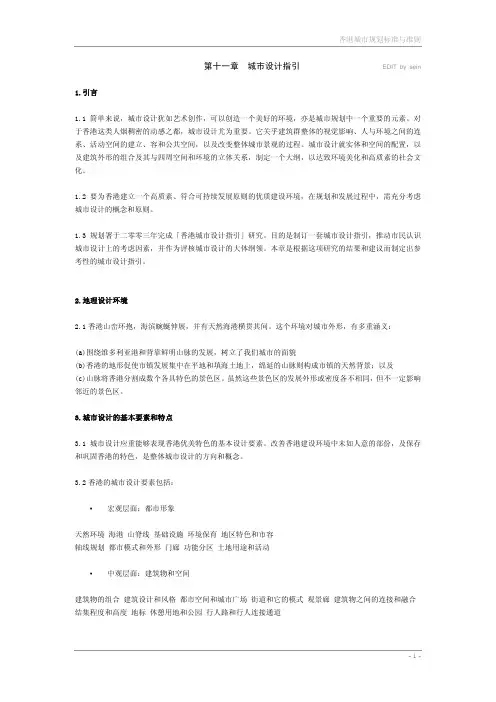

HONG KONG : THE FACTSNew Towns and New Major Urban DevelopmentsCivil Engineering and Development Department: The New Territories Development Department (NTDD) was established in 1973 to implement the New Town Development Programme. In 1986, NTDD amalgamated with the then Urban Area Development Office to form the Territory Development Department (TDD), which took up the responsibility for district management and new major developments on Hong Kong Island and Kowloon in addition to the new towns. In July 2004, the Civil Engineering Department merged with the TDD to form a new works department – The Civil Engineering and Development Department (CEDD).CEDD ensures that the development process for new towns, rural townships and new major developments in the urban area are properly co-ordinated.The basic concept for developing a new town is to provide a balanced and self-contained community as far as possible in terms of provision of infrastructure and community facilities. In rural townships, the major focus is to improve and supplement existing infrastructure and community facilities and, where necessary, provide village flood protection schemes. For new major developments in the urban area, new land will be formed to allow growth, to decant existing population and to provide or upgrade facilities to enable the re-development of old run-down areas. The functional, environmental and aesthetic aspects of the developments are given priority consideration.New Town Development: Hong Kong has developed nine new towns since the initiation of its New Town Development Programme in 1973 to cope with the increase in population and to improve the living environment by de-centralising the population from the over-crowded urban districts. The target at the commencement of the New Town Development Programme was to provide housing for about 1.8 million people in the first three new towns, namely, Tsuen Wan, Sha Tin and Tuen Mun. The population of Hong Kong at that time was about 4.2 million. It is now about 7.0 million.The nine new towns are classified into three generations. The first (Tsuen Wan, Sha Tin and Tuen Mun) started work in the early 1970s; then the second (Tai Po, Fanling/Sheung Shui and Yuen Long) in the late 1970s; and the third (Tseung Kwan O, Tin Shui Wai and Tung Chung) in the 1980s and 1990s. The current population of these nine new towns is about 3.3 million and is expected to rise to 3.5 million in 2016.All the new towns accommodate public and private housing supported by essential infrastructure and community facilities. External transport links are well developed with all new towns now served by rail links to the urban area and good road links to the adjacent districts. Further enhancements of road links in the various new towns are still on-going. TsuenWan:Tsuen Wan New Town covers Tsuen Wan, Kwai Chung and Tsing Yi Island with a total development area of about 3 285 hectares for a planned population of 857 400. The new town’s population is about 884 700 at present.Tsuen Wan was an industrial area. Although most of the factories have been relocated to the Mainland, Tsuen Wan still retains its character as an industrial hub. The new town has Hong Kong’s nine container terminals in its midst in Kwai Tsing.A number of major highway projects have been completed or are under construction to further extend and complement the main road network to cater for the increased traffic in the area. Route 8 between Tsing Yi and Cheung Sha Wan was completed and opened to traffic in December 2009. Widening of the existing Yeung Uk Road between Tai Ho Road and Ma Tau Pa Road commenced in October 2008 with a target completion date in mid-2011.The new town is served by the Mass Transit Railway.Sha Tin:Sha Tin has grown from a rural township of about 30 000 people in the early 1970s to a major community of about 634 100 people today. Sha Tin New Town (including Ma On Shan) has a total development area of about 3 591 hectares for a planned population of 735 000. The new town is built on land mainly reclaimed from the Tolo Harbour.The new town is well connected to the urban area by a strategic road network including four tunnels and the Mass Transit Railway East Rail and Ma On Shan Rail.Tuen Mun: Tuen Mun New Town, in the western New Territories, is developed mainly on land reclaimed from Castle Peak Bay and platforms formed in the valley between Castle Peak and the Tai Lam Hills. It covers a total development area of about 3 259 hectares for a planned population of 649 400. The new town’s population is about 506 000 at present.Hong Kong’s River Trade Terminal was built on reclamation to the southwest part of the new town and operates as a transit point for containers and bulk cargo shipped between Hong Kong and the Pearl River Delta ports. The adjacent reclamation is used for special industries with Lung Fu Road (Foothill Bypass) serving the developments there.The new town is served by a good road network, the West Rail and the Light Rail.Tai Po: Formerly a traditional market town, Tai Po is now home for about 267 400 people. The new town covers a development area of about 2 898 hectares for a planned population of 347 000.Pak Shek Kok development, which covers an area of 118 hectares north of the Chinese University of Hong Kong, includes a Science Park, housing, strategic recreation and tertiary education expansion. Reclamation has been completed and the engineering infrastructure works are being implemented in stages to match with theScience Park Development and other planned developments.East Rail and ample trunk roads provide good transport links for this new town.Fanling/Sheung Shui: The total development area is about 768 hectares. Like Tai Po, Fanling and Sheung Shui are former traditional market towns with a current population of about 254 500. Upon full development, the population will reach 290 900. Fanling and Sheung Shui are served by the East Rail and good road links to adjacent districts and beyond.Yuen Long: Yuen Long is another new town having a traditional market town background. The total development area is about 561 hectares. Its present population is about 139 500. Upon full development, the population will reach 196 000.West Rail, Light Rail and the trunk road network provide good transport links to the adjacent districts and to the urban area. To cope with future development in the southern part of Yuen Long, a new road network was completed at the end of 2006.All main drainage channel projects undertaken by CEDD in Yuen Long area were completed in 2006. Flooding threat to Yuen Long area is reduced substantially.Tin Shui Wai:Tin Shui Wai was built on land reclaimed from low lying areas off Deep Bay. It has a total development area of 430 hectares for a planned population of 306 400. The current population is about 292 300. The new town has a wetland park.West Rail, Light Rail and the trunk road network provide good connections to Yuen Long, Tuen Mun and to the urban area.Tseung Kwan O:The current population of the new town is about 359 100. The total development area is about 1 738 hectares for a planned population of 450 000.The new town is served by three external road links and a good road network and also by the Mass Transit Railway Tseung Kwan O Line. Major road infrastructure being planned includes Cross Bay Link and another external road link Tseung Kwan O – Lam Tin Tunnel.Further development will feature reduced residential density in the new development areas at Town Centre South and Pak Shing Kok with open parks, recreational facilities and a vibrant waterfront. Implementation of the supporting infrastructure commenced in phase in March 2009.Tung Chung: Tung Chung in North Lantau is being developed in phases. Phase I was completed in 1997 providing a community of about 18 000 people to support Chek Lap Kok Airport. Phases II and Reclamation for Phase 3A had also been completed. The total development area is about 155 hectares and the current population is about 83 000. Further studies will be conducted to review and establish the feasibility of the remaining development in Tung Chung to accommodate an overall target population of about 220 000.The new town is linked to the rest of Hong Kong by the North Lantau Highway and the high speed Airport/Tung Chung Railway.New Development Areas in the New Territories: Previous planning and development studies have established the feasibility of developing New Development Areas (NDAs) in the New Territories, including Kwu Tung North, Fanling North, Ping Che/Ta Kwu Ling (3-in-1 Scheme) and Hung Shui Kiu (HSK). To formulate proposals for development and to work out implementation strategy, a further planning and engineering study on the 3-in-1 Scheme commenced in June 2008 for completion in 2011. A similar study on HSK NDA is currently scheduled for commencement in 2011.Lok Ma Chau Loop: With an area of about 87 hectares, the Lok Ma Chau Loop (the Loop) has been identified as an area having development potential for special uses pertinent to its strategic boundary location. In collaboration with the Shenzhen Municipal Government, an integrated planning and engineering study on the development of the Loop commenced in June 2009 for completion in 2012.Liantang/Heung Yuen Wai Boundary Control Point: The project is to develop a new boundary control point (BCP) in the border area of North-eastern New Territories. It comprises formation of about 23 hectares of land, provision of BCP buildings and associated facilities, construction of a 11km long dual 2-lane connecting road, improvement of about 4.5 km long section of Shenzhen River, the associated infrastructure and landscaping works. The construction works of this project are planned to commence in 2013 for completion not later than 2018.Urban Development AreasCentral and Wan Chai Reclamation:The Central and Wan Chai Reclamation is being developed in phases and will accommodate strategic road and rail links along the north shore of Hong Kong Island between Central and Eastern Districts. Central Reclamation Phases I and II and Wan Chai Reclamation Phase I have been completed to accommodate, apart from the road and rail links, the Hong Kong Station of the Airport Railway and the Hong Kong Convention and Exhibition Centre extension.Central Reclamation Phase III is in progress and is scheduled for completion by end 2011. Review for Wan Chai Development Phase II has been completed. The new reclamation scheme, the at-grade road scheme and the proposed amendments to the draft Wan Chai North OZP and the North Point OZP were gazetted in July 2007 and authorized by the Chief Executive in Council in May 2009. The funding application for the project was then approved by the Finance Committee of the Legislative Council on 3 July 2009 for upgrading to Category A. The construction works subsequently commenced at end 2009 for completion in 2017.Kai Tak Development: The development spans over 320 hectares covering the former Kai Tak Airport site and adjoining areas. Key development components include a cruise terminal, a multi-purpose stadium complex, a heliport, a government office, a metro park and a runway park, public housing sites, Shatin to Central Link and Trunk Road T2. The Kai Tak OZP was approved in November 2007 to provide a statutory framework for the developments in the area. The remaining site preparation and decontamination works at the former south apron were completed in early 2010. Infrastructure works to serve the early developments at the ex-runway and former north apron such as the new cruise terminal and the public housing started in mid 2009. Site formation works for the new cruise terminal also commenced in end 2009. Design of the remaining infrastructure is under way.Choi Wan Road and Jordan Valley Development: The project comprises formation of about 20 hectares of platforms and provision of necessary infrastructure for housing, school and open space developments. Works commenced in 2001 and have been completed in stages from 2005 to 2010 to tie in with the housing and school development programme.West Kowloon Cultural District (WKCD): The WKCD project involves the development of a prime waterfront site of about 40 hectares, located at the southern tip of West Kowloon Reclamation Area, into a world class integrated arts and cultural district. The WKCD Authority, established under the West Kowloon Cultural District Authority Ordinance, is conducting a three-stage public engagement exercise to collect public views for formulating the WKCD development plan. Close liaison with the WKCD Authority will be maintained to takeforward the infrastructure works and communal facilities within and adjoining the WKCD to be funded by the Public Works Programme.In order to maximize the use of the prime waterfront site for enjoyment by the general public before commencement of construction works under the WKCD project, the development of the West Kowloon Waterfront Promenade and the subsequent enhancement works were completed, and the promenade has been fully opened to public since February 2007.Anderson Road Development: The project comprised formation of about 20 hectares of land platforms and the associated infrastructure in Sau Mau Ping for the development of public housing as well as other government, and public facilities. The works commenced in 2008 for completion in December 2014.。
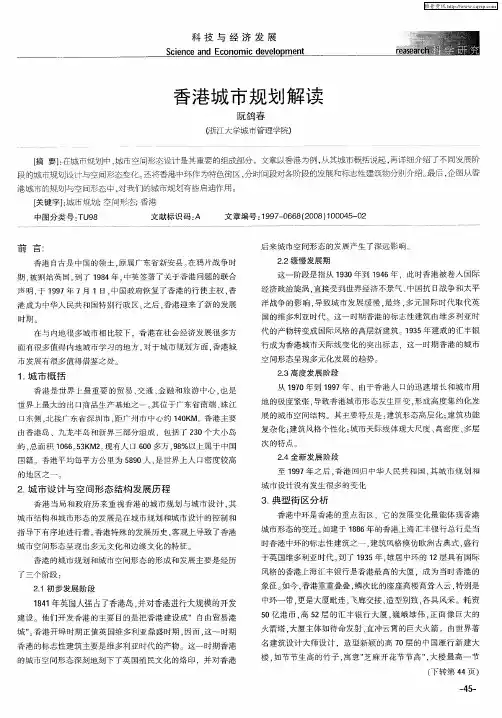
![[2017年整理]香港的城市规划体系](https://uimg.taocdn.com/bd43f647f11dc281e53a580216fc700abb6852e1.webp)
香港的城市规划体系——规划运作体系一、发展规划香港的发展规划分为全港、次区域和地区三个层面,因而形成港发展策略、次区域发展策略及地区图则三层架构的发展规划系统。
《香港规划标准与准则》是技术政策文件,列明各类土地用途在设施配置方面的标准,同时也为公私发展计划的规划大纲提供指导。
1、全港和次区域发展策略全港发展策略制订长远规划大纲,贯彻政府的土地用途、交通基础设施及环境方面的政策,作为次区域及地区规划的依据。
次区域发展策略将全港发展目标在五个次区域(即都会区、新界东北、新界西北、新界东南及新界西南)演绎为更具体的规划目标。
2、地区图则地区图则是详细的土地用途图则,将全港及次区域层面的概要规划原则在地区层面加以落实。
地区图则分为法定图则及政府内部图则两类。
法定图则根据《城市规划条例》而制订,包括分区计划大纲图和发展审批地区图。
分区计划大纲图明确规划分区内的拟议土地用途(包括住宅、商业、工业、游憩用地、政府/团体/社区用途、绿化地带、保护区、综合发展区、乡村式发展、露天存货或其它指定用途)和主要道路系统。
分区计划大纲图附有注释,列出分区内通常准许的用途(第1栏用途),以及其它须取得规划委员会许可的用途(第2栏用途)。
发展审批地区图主要为非城市地区而制订的过渡性图则,有效期为3年,期间可由分区计划大纲图取代。
3、规划图则的编制依照《城市规划条例》的法定程序,法定图则由规划委员会遵照特区行政长官会同行政局的指令制订。
在制订新的分区计划大纲图或对现有图则进行重要修订前,须先公布规划研究报告,供公众查阅和发表意见。
规划委员会在制订或修订图则时,将会考虑规划研究报告和公众意见。
图则草案送交各有关部门传阅以征询意见,然后提交有关的规划小组委员会审议。
如规划小组委员会认为适当的话,该图便会提交有关的区议会征询意见,然后再由规划委员会考虑区议会的意见。
图则草案公开展示2个月,供市民发表意见,受图则影响的人士可在些期间提出反对。
可持续发展视角下的香港城市规划1. 引言1.1 什么是可持续发展视角下的香港城市规划可持续发展视角下的香港城市规划是指在城市规划过程中,根据可持续发展的原则和理念,结合香港特定的地理环境、社会文化和经济发展状况,制定出一系列旨在保障当前和未来世代生活质量、保护环境资源、促进经济繁荣的规划政策和措施。
可持续发展视角下的香港城市规划更加关注人与自然之间的平衡,致力于建设一个环保、宜居、繁荣的城市。
在可持续发展的视角下,香港城市规划不再仅仅追求经济增长和城市扩张,而是更加重视生态平衡、资源利用效率和社会公平。
通过合理规划城市用地、优化交通网络、促进绿色建筑和能源节约等措施,香港可以实现城市可持续发展的目标,提高城市整体竞争力,改善居民生活质量。
可持续发展视角下的香港城市规划是香港未来发展的必然选择,也是推动全球城市可持续发展的重要尝试。
1.2 香港城市规划的重要性香港城市规划的重要性不容忽视。
只有通过科学合理的规划,香港才能实现可持续发展,提高居民的生活质量,同时增强城市的整体形象和竞争力。
2. 正文2.1 香港城市规划的历史背景香港城市规划的历史背景可以追溯到19世纪。
随着香港逐渐成为一个重要的商业和贸易中心,城市规划也开始受到越来越多的关注。
最早的城市规划尝试可以追溯到英国殖民时期,当时主要集中在维多利亚城市的建设和基础设施发展。
随着香港人口的增长和城市化进程加快,城市规划变得愈发重要。
20世纪初,香港开始面临城市化带来的挑战,城市人口快速增长,城市基础设施不断完善。
随着城市规模的扩大,城市规划开始涉及更多领域,包括住房、交通、环境等方面。
此时的城市规划更多集中在解决城市发展中的实际问题,确保城市的可持续性发展。
随着时间的推移,香港的城市规划逐渐转向更加注重可持续发展的方向。
随着人们对环境保护和资源利用的重视,城市规划也开始注重减少对自然环境的破坏,提高城市的生态环境质量。
目前,香港的城市规划已经成为一个综合性的体系,涵盖了各个方面,力求实现城市的平衡发展和可持续性发展。
政策及背景资料-城市规划制度(80年代)香港的城市规划系统主要由规划署及城市规划委员会管辖。
规划署为房屋规划地政局其中一个行政署,分为全港规划处以及地区规划处。
全港规划处主要负责全港性的规划,包括制定全港发展策略及制定规划标准。
而地区规划处则负责协助城市规划委员会的运做,协助制定法定图则及处理规划申请。
城市规划委员会为香港城市规划制度中非官方的法定机构。
城市规划委员会是根据城市规划条例而成立,职责包括制定法定图则以及处理规划申请。
现时香港城市规划制度中,总共有三种法定图则,分别为分区计划大纲(Outline Zoning Plan ,OZP)、发展审批地区图(Development Permission Area Plan , DPA Plan)以及市区重建局发展计划图(Development Scheme Plan (DSP)。
政府透过这些法定图则来将不同规划区内的土地划做不同地带。
每一个规划区都有一张分区计划大纲图。
为加强对新界农地的管制,部分地区初时会使用发展审批地区图来做出管制,及后才更新为分区计划大纲图。
发展审批地区图不同之处为,如该规划区曾受发展审批地区图管制,政府可根据城市规划条例检控非法用途。
市区重建局发展计划地盘则会由市区重建局发展计划图所涵盖,功能大致上和分区计划大纲图相同。
而为了避免与和郊野公园有关的法例出现双重法定管制,法定图则通常不会涵盖郊野公园范围。
现时香港共有接近六十个规划区,涵盖绝大部分已发展的地方,只有边境禁区范围、以及其它新界及离岛偏远村落没有法定图则涵盖。
部分地区如沙头角市及梅窝则以分区发展大纲图(Outline Development Plan)、发展蓝图(Layout Plan)以及地契做出规划管制。
所有法定图则都会不定期做出修订,每次有新的草图出现,草图都会公开展示,公众可以对草图提出反对及建议。
为迎合反对而做出更改的草图或没有做出更改的草图最终也会送交行政长官会同行政会议审阅,经批准后该法定图则会成为核准图。
香港的城市规划体系——规划运作体系一、发展规划香港的发展规划分为全港、次区域和地区三个层面,因而形成港发展策略、次区域发展策略及地区图则三层架构的发展规划系统。
《香港规划标准与准则》是技术政策文件,列明各类土地用途在设施配置方面的标准,同时也为公私发展计划的规划大纲提供指导。
1、全港和次区域发展策略全港发展策略制订长远规划大纲,贯彻政府的土地用途、交通基础设施及环境方面的政策,作为次区域及地区规划的依据。
次区域发展策略将全港发展目标在五个次区域(即都会区、新界东北、新界西北、新界东南及新界西南)演绎为更具体的规划目标。
2、地区图则地区图则是详细的土地用途图则,将全港及次区域层面的概要规划原则在地区层面加以落实。
地区图则分为法定图则及政府内部图则两类。
法定图则根据《城市规划条例》而制订,包括分区计划大纲图和发展审批地区图。
分区计划大纲图明确规划分区内的拟议土地用途(包括住宅、商业、工业、游憩用地、政府/团体/社区用途、绿化地带、保护区、综合发展区、乡村式发展、露天存货或其它指定用途)和主要道路系统。
分区计划大纲图附有注释,列出分区内通常准许的用途(第1栏用途),以及其它须取得规划委员会许可的用途(第2栏用途)。
发展审批地区图主要为非城市地区而制订的过渡性图则,有效期为3年,期间可由分区计划大纲图取代。
3、规划图则的编制依照《城市规划条例》的法定程序,法定图则由规划委员会遵照特区行政长官会同行政局的指令制订。
在制订新的分区计划大纲图或对现有图则进行重要修订前,须先公布规划研究报告,供公众查阅和发表意见。
规划委员会在制订或修订图则时,将会考虑规划研究报告和公众意见。
图则草案送交各有关部门传阅以征询意见,然后提交有关的规划小组委员会审议。
如规划小组委员会认为适当的话,该图便会提交有关的区议会征询意见,然后再由规划委员会考虑区议会的意见。
图则草案公开展示2个月,供市民发表意见,受图则影响的人士可在些期间提出反对。
香港城市規劃委員會(文件已於二零零七年十月五日解密)城市規劃委員會二零零七年九月七日舉行的第893次會議記錄議程項目5提交根據《市區重建局條例》第25條擬備的《市區重建局觀塘市中心-主地盤和月華街地盤發展計劃草圖編號S/K14S/U R A1/A和S/K14S/U R A2/A》(城規會文件第7894號)商議部分1.主席表示,城規會在是次會議上應集中討論發展計劃圖的界線、採用兩份發展計劃圖的做法以及規劃大綱擬稿所載的規劃參數。
與發展計劃有關的設計和技術事宜應由市區重建局(市建局)在總綱發展藍圖和詳細設計階段加以處理。
2.部分委員在考慮到計劃可行性、計劃的整體設計、綠化地區的提供以及與鄰近建築物的協調情況後,同意市建局的擬議地標商業大廈的建築物高度。
另外有部分委員在考慮到附近地區的建築物管制以及山脊線遭破壞的情況後,對此表示有保留。
3.一名委員指地標建築物的擬議高度較毗鄰的A P M高出40%,從整體城市設計的觀點來看,並不恰當。
鑑於城規會過往對興建高樓大廈的一貫做法,若是次批准在觀塘市中心興建高度達主水平基準上280米的商業大廈,恐怕會招致公眾,特別是環保團體的批評。
4.部分委員詢問,城規會可否以計劃的可行性為依據考慮發展計劃圖。
秘書在回應時表示,根據上訴法庭過往就市建局士丹頓街/永利街項目所作的裁決,城規會就發展計劃圖作出決定時,可考慮計劃的可行性,但並非必定要取得該等資料。
由於市建局提供的資料不足,故此上訴法庭認為城規會未有充分考慮士丹頓街/永利街項目這方面的事宜。
最終,儘管城規會提出要求,但市建局卻以機密為理由拒絕透露有關該項目的財政狀況。
至於觀塘市中心重建方面,在市建局未有提供詳細資料的情況下,城規會商議發展計劃圖時不應太着重財務可行性。
5.部分委員對建築物高度問題有以下的意見和關注:(a)觀塘市中心的地標設計應與其鄰近發展相互協調,而且地標並非必定是高樓大廈;(b)憑藉創新的設計,現時建議的蛋型政府、機構或社區建築物、水簾設計或綠化地區亦可作為觀塘市中心的地標;以及(c)為補償因商業大樓高度降低而引致的樓面面積損失,市建局可探討能否增加蛋型政府、機構或社區建築物的高度,或擴充地庫的商業用途。
香港规划标准与准则香港一直以来都是一个繁荣发达的城市,其城市规划和建设也备受瞩目。
香港规划标准与准则是香港特别行政区政府制定的一系列城市规划和建设准则,旨在指导和规范城市发展,确保城市的可持续发展和宜居性。
本文将就香港规划标准与准则进行介绍和分析。
首先,香港规划标准与准则涵盖了多个方面,包括土地利用、交通、环境保护、建筑设计等。
其中,土地利用是其中一个重点,香港的土地资源一直都是紧缺的,因此合理的土地利用显得尤为重要。
规划标准与准则对土地的分类、开发密度、用途等都有详细的规定,以确保土地的合理利用和保护。
其次,交通规划也是香港规划标准与准则的重要内容之一。
香港作为一个国际大都会,交通拥堵问题一直备受关注。
规划标准与准则针对不同区域的交通需求,提出了相应的交通规划方案,包括道路建设、公共交通系统的完善等,以解决交通拥堵和提高交通效率。
另外,环境保护也是香港规划标准与准则的重要内容之一。
作为一个高度城市化的地区,环境保护一直是香港的重要议题。
规划标准与准则对环境保护提出了一系列的要求和措施,包括绿化率、污染治理、水源保护等,以保护城市的生态环境和改善居民的生活质量。
最后,建筑设计也是香港规划标准与准则的重要内容之一。
规划标准与准则对建筑的高度、密度、外观等都有详细的规定,以保障城市的整体建筑风貌和居民的居住质量。
总的来说,香港规划标准与准则是香港城市规划和建设的重要指导文件,它涵盖了多个方面,旨在指导和规范城市的发展。
在实际的城市规划和建设中,各项规定和要求都需要得到严格执行,以确保城市的可持续发展和居民的生活质量。
同时,随着社会的不断发展和变化,香港规划标准与准则也需要不断进行修订和完善,以适应城市发展的新需求和新挑战。